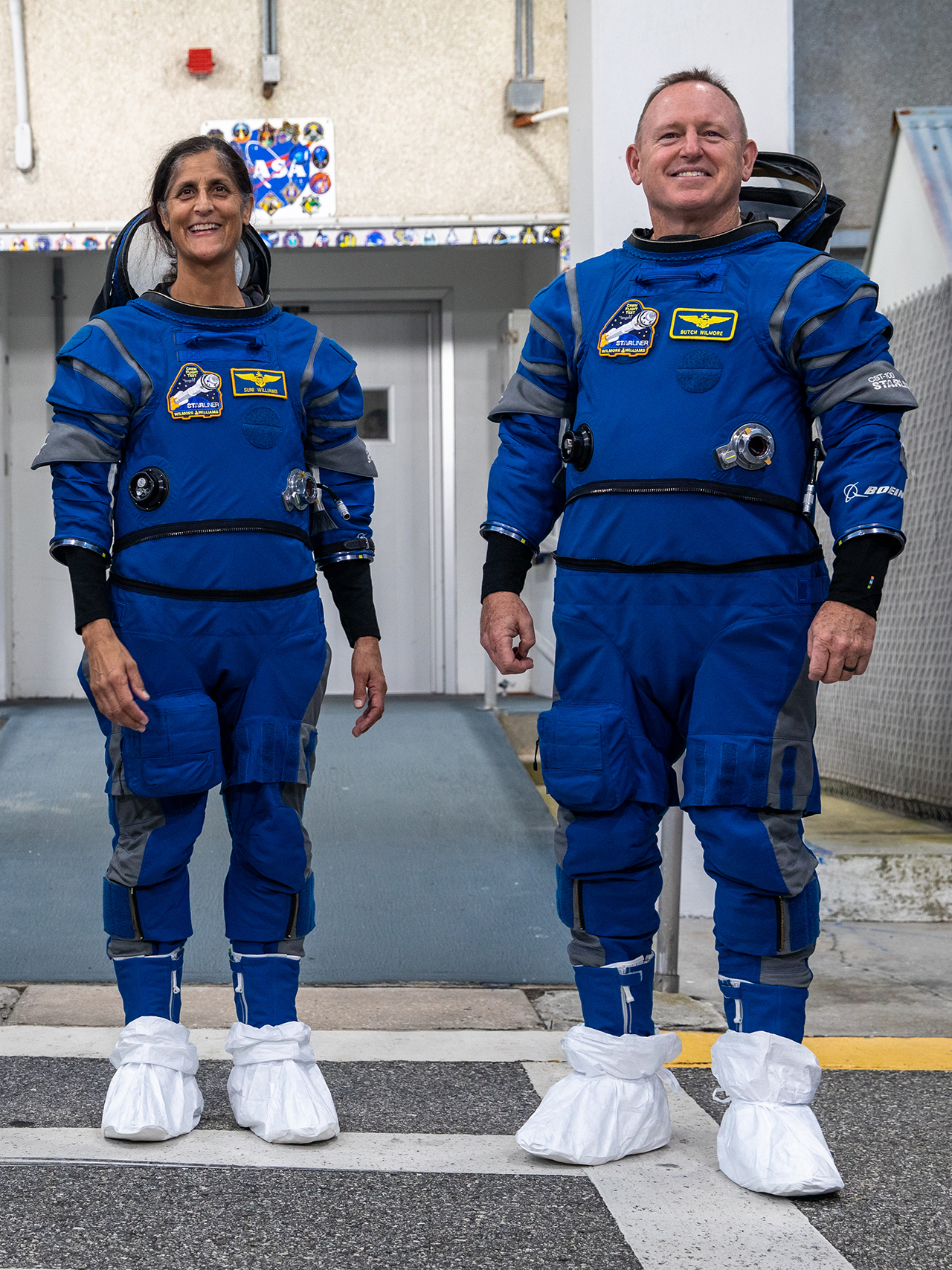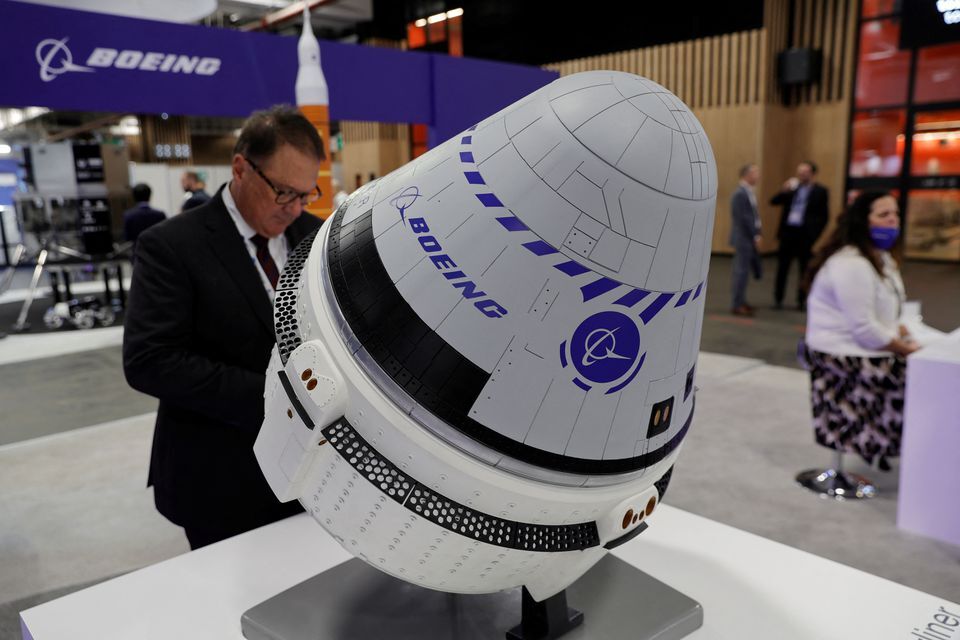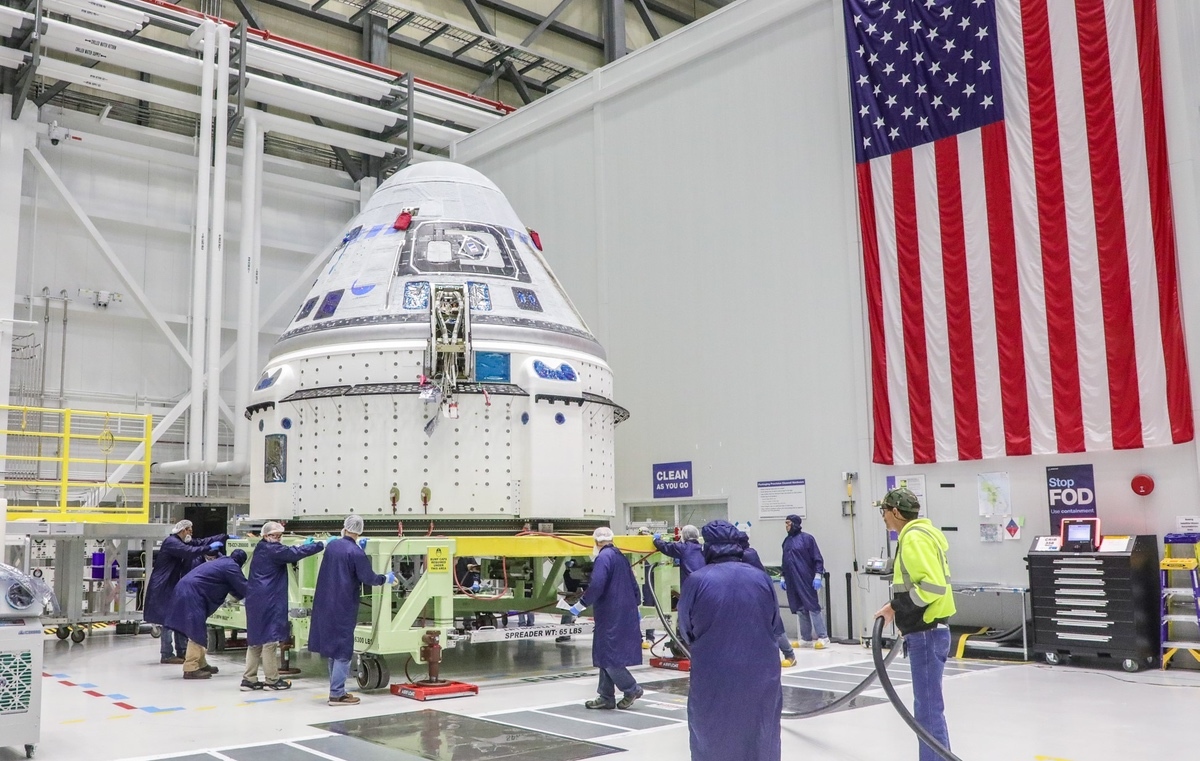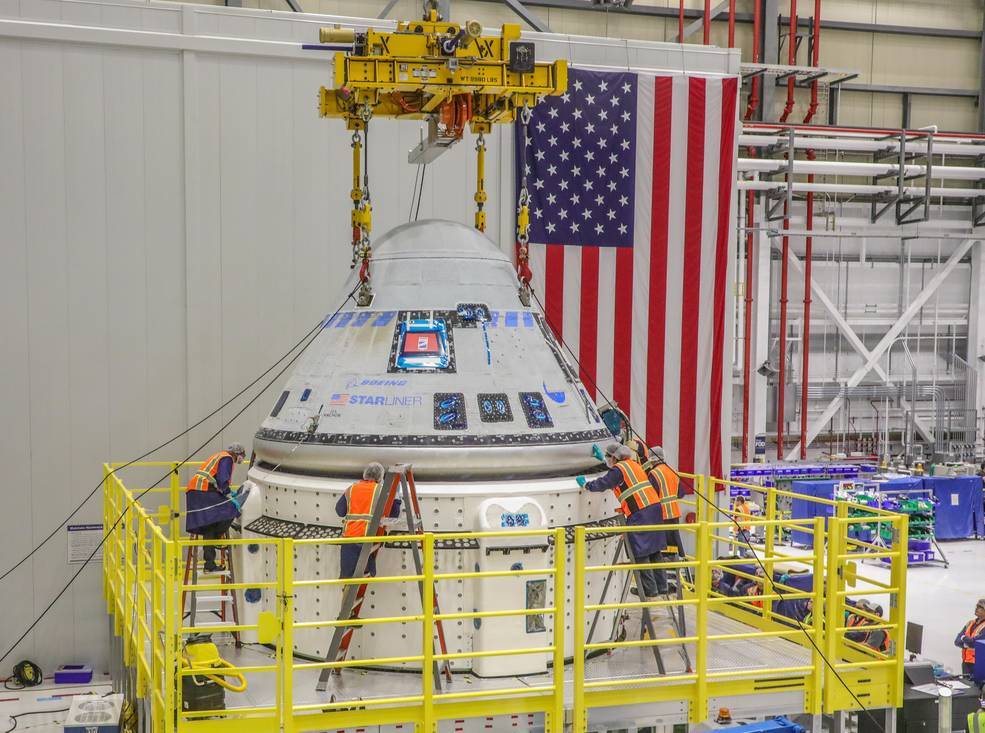27.08.2022
Starliner crewed test flight slips to early 2023
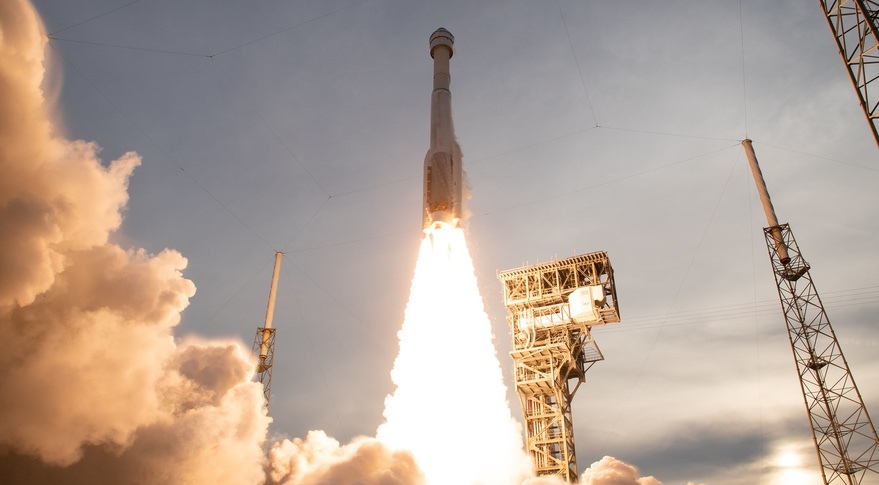
WASHINGTON — Work on Boeing’s CST-100 Starliner commercial crew vehicle to correct minor problems during an uncrewed test flight in May will delay its first flight with astronauts to early 2023, NASA and Boeing said Aug. 25.
The Crew Flight Test (CFT) mission, with NASA astronauts Suni Williams and Butch Wilmore on board, is now scheduled to launch no earlier than February 2023. Boeing had been preparing to fly CFT as soon as this December immediately after completing the Orbital Flight Test (OFT) 2 test flight in May.
Mark Nappi, vice president and program manager for Starliner at Boeing, said during a media teleconference that a review of the data from the OFT-2 mission, which is now wrapping up, shows the need for a “minimal amount of changes” to the Starliner that will fly the CFT mission, a process he called “fine-tuning” and which he said the company expected from the earlier test flight.
That work, though, ruled out any chance of a CFT mission this year. “We had schedules that supported late ’22, the December timeframe, for CFT,” he said. “There were areas that we needed to go do a little bit more work on the systems. We plugged that into the plan and that’s what moved us out by a month, five weeks or so.”
That work addresses problems that came up during the OFT-2 flight, including Orbital Maneuvering and Attitude Control (OMAC) thrusters that shut down during the orbital insertion burn. Nappi said some “debris-related conditions” likely caused those thrusters to shut down, but later noted that is their best estimate since the OMAC thrusters are in a service module that burns up on reentry and is not recovered.
“We do not know where the debris may have come from,” he said. “The bottom line is that it looks to be the leading root cause, and we’ve eliminated that by looking at the CFT vehicle and making sure that there’s absolutely no debris in the system.”
Several reaction control thrusters also shut down during the mission, which Nappi said was likely due to low inlet pressures and can be addressed with a “tweak in timing and tolerances” in software. High pressures in a thermal control loop noticed in the mission were linked to filters that engineers determined are not needed and can be removed. A guidance system on the spacecraft called VESTA worked well but generated more data than the flight software could handle, requiring changes to the software.
Work on the Starliner vehicle that will fly CFT, which includes the same crew module that flew the original OFT mission in December 2019, is on track, Nappi said. That crew module will be mated to its service module in November, “and we have good plans to get us to support that date in February.”
Boeing is not planning to make major changes to the valves in the service module for CFT. Those valves suffered corrosion before an OFT-2 launch attempt in August 2021 when ambient moisture reacted with nitrogen tetroxide propellant that seeped through the valve, creating nitric acid that corroded aluminum elements of the valve. For the May OFT-2 launch, Boeing took steps to purge moisture from the valves and regularly open them to confirm they worked.
“We feel that we have a good short-term solution that we are enhancing slightly for CFT because it’s being implemented during the build and not after the vehicle was built,” he said. “We’re flying that same configuration on CFT.”
Boeing is continuing to study long-term changes that would involve sealing off the valves from moisture and replacing aluminum in them. “Our goal is to get it done as soon as possible,” he said, but added the schedule was tight to have it ready in time for the first operational Starliner mission, tentatively scheduled for the fall of 2023.
A CFT mission to the International Space Station, docked there for eight days, would have to work around an “incredibly busy” schedule there in the first half of the year, said Joel Montalbano, NASA ISS program manager. By early March there will be a Soyuz crew exchange, followed by the Crew-5/Crew-6 exchange of Crew Dragon missions. Also on the manifest are cargo Dragon, Cygnus and Progress missions and Axiom Space’s Ax-2 private astronaut mission.
He said, though, that flying CFT will be a priority so that the vehicle can be certified in time for its first operational mission in the fall. “CFT is a big deal for us,” he said. “When these guys are ready in February, we’ll be making sure there’s room for them, and they will be a high priority unless we’re working a major issue on board space station.”
Montalbano added that he expects to start discussions with the Russian space agency Roscosmos in the fall to update the existing “integrated crew” agreement signed in July to exchange seats between Soyuz and commercial crew vehicles. The current agreement covers one exchange a year between Soyuz and Crew Dragon in 2022, 2023 and 2024.
The modification, he said, would include Starliner and extend the agreement beyond 2024. “The goal is a long-term agreement where, every time we fly, we have a cosmonaut on either SpaceX or Boeing and then an astronaut on the Soyuz spacecraft.”
Boeing, in its second quarter financial results release July 27, said it recorded a $93 million charge in the quarter from its commercial crew program, “driven by launch manifest updates and additional costs associated with OFT-2.” Boeing has now recorded $688 million in charges related to development of Starliner dating back to early 2020.
Quelle: SN
----
Update: 2.10.2022
.
NASA Updates Crew Assignments for First Starliner Crew Rotation Flight
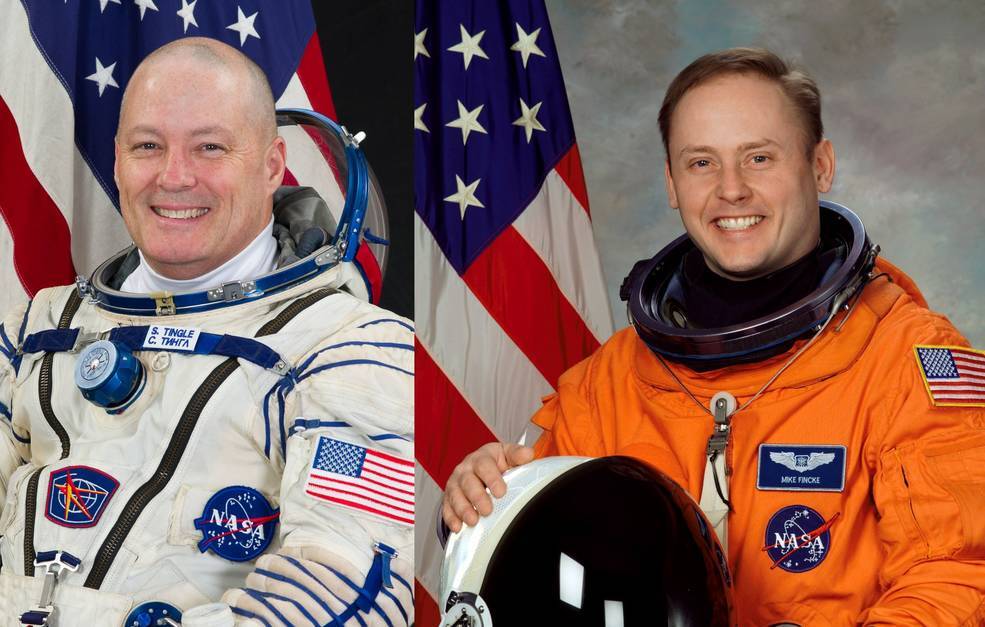
NASA has added two astronauts to the agency’s Boeing Starliner-1 launch to the International Space Station, the spacecraft’s first mission following completion of its flight tests and certification.
Astronauts Scott Tingle and Mike Fincke of NASA will serve as the CST-100 Starliner spacecraft commander and pilot, respectively, for the mission. Both astronauts have previously flown as crew members aboard the space station.
NASA astronaut Jeanette Epps remains assigned as a mission specialist on Starliner-1. Epps also continues cross-training on the Dragon spacecraft to protect for other flight opportunities.
The agency’s Starliner crew rotation missions to the space station will carry four crew members at a time. Future crew assignments for Starliner-1 will be made following review and approval by the agency and its international partners.
Starliner-1 will launch following the successful completion of NASA’s Boeing Crew Flight Test (CFT), which aims to demonstrate Starliner’s ability to achieve NASA certification and safely fly regular crewed missions to space station.
Boeing is targeting launch of its first test flight with astronauts in early February 2023, pending space station program approval, rocket manifest, and confirmation by the Eastern Range. Starliner will launch aboard a United Launch Alliance Atlas V rocket from Space Launch Complex-41 at Cape Canaveral Space Force Station in Florida.
After a successful CFT mission, NASA will begin the final process of certifying the Starliner spacecraft and systems for future crewed missions to the space station as part of the agency’s Commercial Crew Program.
For more than 21 years, astronauts have continuously lived and worked aboard the space station, testing technologies, performing science, and developing the skills needed to explore farther from Earth. Regular commercial crew rotation missions enable NASA to continue the important research and technology investigations taking place aboard the station and prepare for future commercial destinations in low-Earth orbit. As part of Artemis, NASA will send astronauts to the Moon to prepare for future human exploration of Mars. Inspiring the next generation of explorers – the Artemis Generation – ensures America will continue to lead in space exploration and discovery.
Quelle: NASA
----
Update: 28.10.2022
.
Boeing’s Starliner charges approach $900 million
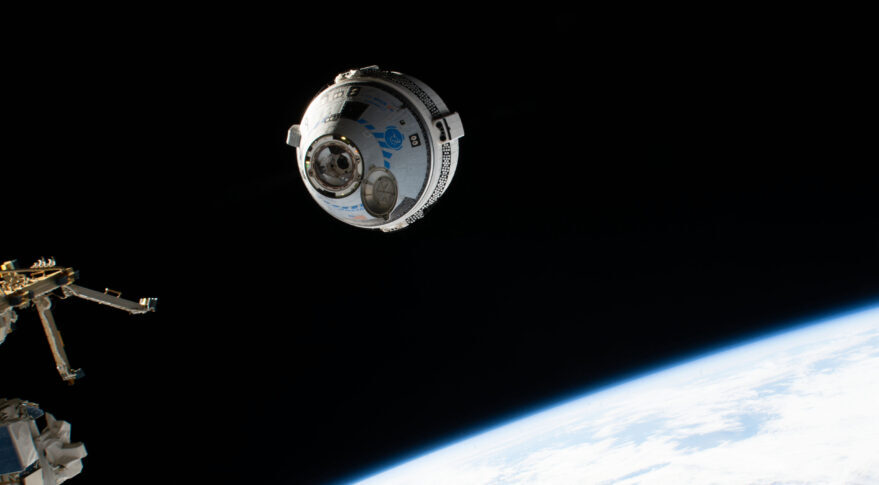
LAS VEGAS — Boeing announced Oct. 26 it will take yet another charge against earnings because of delays in the CST-100 Starliner commercial crew program, bringing the total losses recorded by the company to date on the program to nearly $900 million.
In a filing with the U.S. Securities and Exchange Commission, Boeing announced a charge of $195 million recorded in its fiscal third quarter it blamed on Starliner. It comes after a $93 million charge reported in its second quarter financial results July 27.
The latest charge brings the total losses announced by Boeing on the Starliner program to $883 million dating back to early 2020, when the company took a $410 million charge after a first uncrewed test flight, called Orbital Flight Test (OFT) was cut short by technical problems. The company took an additional $185 million charge in October 2021 when valve problems delayed the OFT-2 mission.
The company blamed the charges in the last two quarters in part on increased costs to get Starliner ready for its first flight with astronauts on board, the Crew Flight Test (CFT) mission, now scheduled for no earlier than February 2023. That will allow operational, or post-certification, missions for NASA to begin as soon as the fall of 2023.
Boeing said the major factor in the latest charge was a change in schedule for those post-certification missions. “The increase recorded in the third quarter of 2022 was primarily driven by timing of the three future post certification missions which are now assumed to be completed by 2026 based on NASA’s revised launch plans,” the company stated in its SEC filing. “We had previously assumed that the post certification missions would be completed by 2024.”
NASA officials have stated that, once Starliner is certified after the CFT mission, it will alternate with SpaceX’s Crew Dragon, which has been performing all of NASA’s commercial crew missions since being certified after the Demo-2 test flight in mid-2020. Each company would thus conduct one commercial flight for NASA per year.
Boeing’s commercial crew contract that NASA awarded in 2014 includes six post-certification missions. NASA awarded the same amount to SpaceX but has twice added missions to the contract, bringing the total to 14 as of the end of August.
Boeing did not discuss in detail commercial crew charge in the press release it issued about its quarterly financial results, stating only that it recorded losses on commercial crew as well as four aircraft programs in its Defense, Space and Security business unit. The company also did not mention the commercial crew charge in an earnings call.
The company did caution in the SEC filing that this latest charge may not be the last for the Starliner program. “Risk remains that we may record additional losses in future periods,” it stated.
Quelle: SN
----
Update: 6.11.2022
.
NASA again delays the debut crewed flight of Boeing's troubled Starliner spacecraft
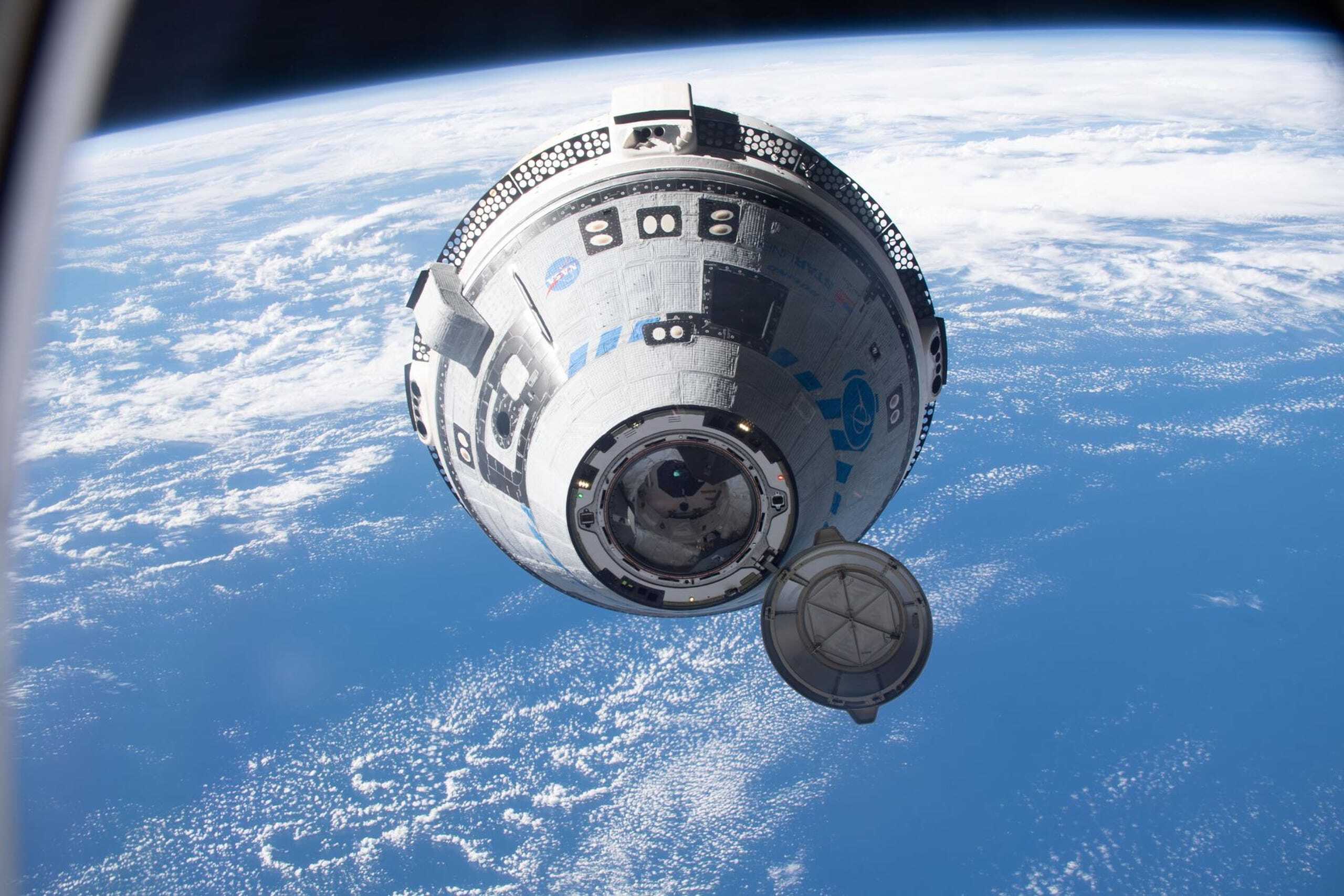
NASA announced new launch dates of its 2023 astronaut missions to the International Space Station and Boeing's debut crewed mission picked up another two-month delay.
The troubled Starliner capsule now won't get its opportunity to launch with crew members any time before April 2023. That's two months later than the previous February 2023 launch date.
The agency said in a blog post that the decision to push back Starliner's Crew Flight Test "deconflicts visiting spacecraft traffic at the space station." NASA also explained it's still working with Boeing to address several remaining issues following the less-than-perfect uncrewed OFT-2 test last May. More information beyond "a variety of verification efforts across several critical systems," was not disclosed however.
The Starliner experienced multiple issues with thruster corrosion prior to an OFT-2 launch attempt and multiple thruster performance issues during the flight test in May. Unfortunately, those thrusters were located on the Starliner's service module which is discarded during re-entry before landing.
In August, Mark Nappi, Boeing Starliner program manager, told reporters, that Boeing teams have made sure "that same condition doesn't exist."
In NASA's blog post, the agency said that all crewed flight test hardware components including the Starliner and the rocket it will launch on, United Launch Alliance's Atlas V, are on track to be completed in the early part of 2023.
The Starliner capsule slated to launch Boeing's first crew of astronauts is a reused one from the first uncrewed orbital flight test back in 2019 called "Calypso."
Boeing recently completed refurbishing the exterior and installing the heat shield. It will be mated with its service module later this year at Boeing's factory located at Kennedy Space Center. That was originally set to occur this month.
Whenever it launches, Starliner's crewed flight test mission will carry NASA astronauts Barry Wilmore and Suni Williams to the ISS for about two weeks.
The goal, to certify Boeing's Starliner human transportation system for future long-duration ISS missions for NASA. The first operational mission won't have an anticipated launch date until the CFT is deemed successful.
Quelle: Florida Today
----
Update: 9.11.2022
.
NASA astronauts debut new patch for Boeing Starliner crew flight test
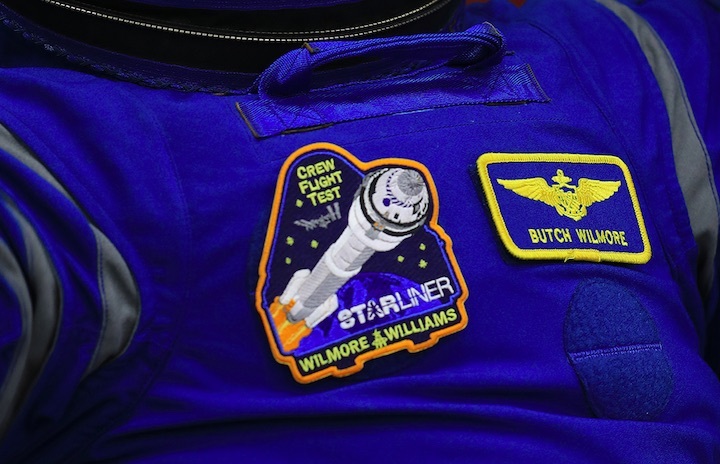
Boeing Starliner Crew Flight Test (CFT) commander Barry "Butch" Wilmore wears the new mission patch for his and Suni Williams' 2023 launch to the International Space Station. (NASA/Kim Shiflett)
The first astronauts set to fly on Boeing's CST-100 Starliner spacecraft debuted a new look for their mission patch during a spacesuit fit check.
Crew Flight Test (CFT) commander Barry "Butch" Wilmore and pilot Suni Williams sported the new insignia during a validation test at the Kennedy Space Center in Florida. The two NASA astronauts, together with their backup Mike Fincke, suited up and tried out the Starliner's pressurized crew module to ensure a good seat fit, suit functionality, audio systems, cabin temperature and day of launch operations.
The test, which Boeing declared a success, was conducted as the Starliner's crew module neared completion and was considered "a measure of confidence" for the astronauts as they continue to work towards their launch, which this month was re-targeted from March to April 2023.
"We are working to have the CFT vehicle ready to fly ahead of the new launch date," Mark Nappi, Boeing's vice president and program manager for the Starliner program, said in a Nov. 3 statement. "With the help of experienced NASA test pilots, Wilmore and Williams, we are closer to our goal of flying a safe and capable spacecraft."
Although the crew validation test was held on Oct. 18, photographs from the event were only released by NASA on Monday (Nov. 7). The images, which showed Wilmore and Williams donning their bright blue pressure suits, also revealed the new CFT mission patch.
Shaped like the Boeing Starliner crew capsule with its attached service module, the emblem depicts the spacecraft launching from Earth atop a United Launch Alliance (ULA) Atlas V rocket. The crew's destination, the International Space Station, is sewn in gray, set against a field of seven yellow stars and the words "Crew Flight Test."
Below the rocket, the patch includes the Starliner logotype and the crew members' names, Wilmore and Williams, separated by the NASA astronaut symbol. The entire insignia is outlined in an orange border, making it stand out from the blue outer fabric of the crew's suits.
The new patch replaces an emblem first introduced in 2019. Created as part of a set, with each patch representing an uncrewed flight test that preceded the CFT, the original insignia was designed with the input of the original flight crew, which did not include Wilmore or Williams.
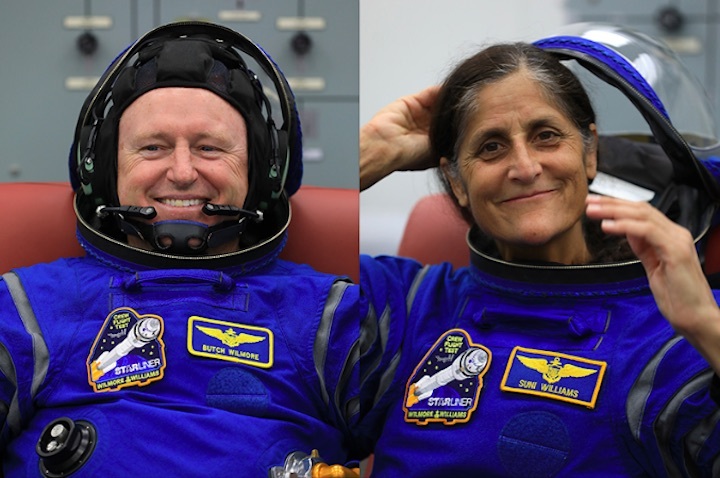
Boeing Starliner Crew Flight Test (CFT) commander Barry "Butch" Wilmore and pilot Suni Williams debut a new look for their mission patch while participating in a crew validation test at NASA's Kennedy Space Center in Florida. (NASA/Kim Shiflett)
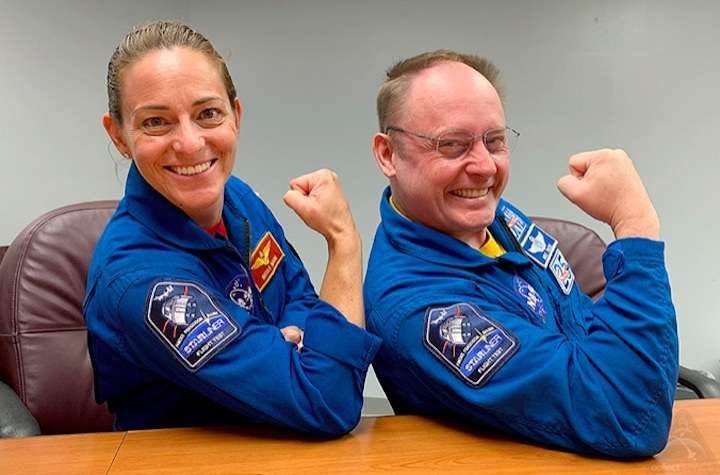
NASA astronauts Nicole Mann and Mike Fincke display the original Boeing Starliner Crew Flight Test (CFT) patch on their shoulders. Both were at one time assigned the CFT crew but were since reassigned to SpaceX's Crew-5 and serving as backup the CFT crew, respectively. (collectSPACE)
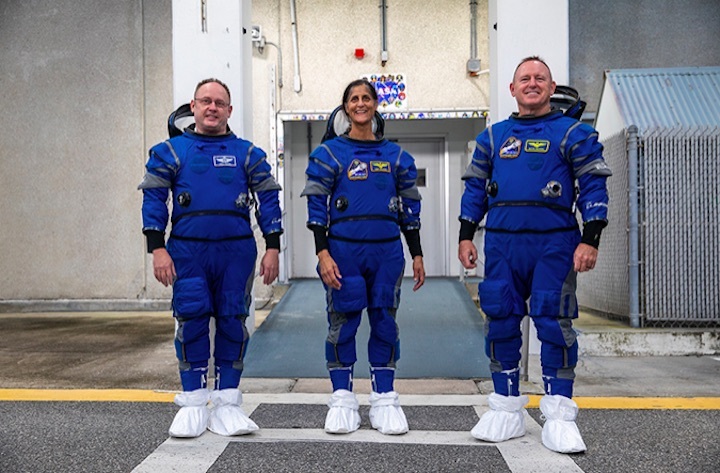
Boeing Starliner Crew Flight Test (CFT) commander Barry "Butch" Wilmore (at right), pilot Suni Williams and backup Mike Fincke outside the Neil A. Armstrong Operations & Checkout Building at NASA's Kennedy Space Center in Florida on Oct. 18, 2022. (NASA/Kim Shiflett)
Quelle: CS
----
Update: 7.01.2023
.
Crew set to fly on Boeing Starliner add final touches to mission patch
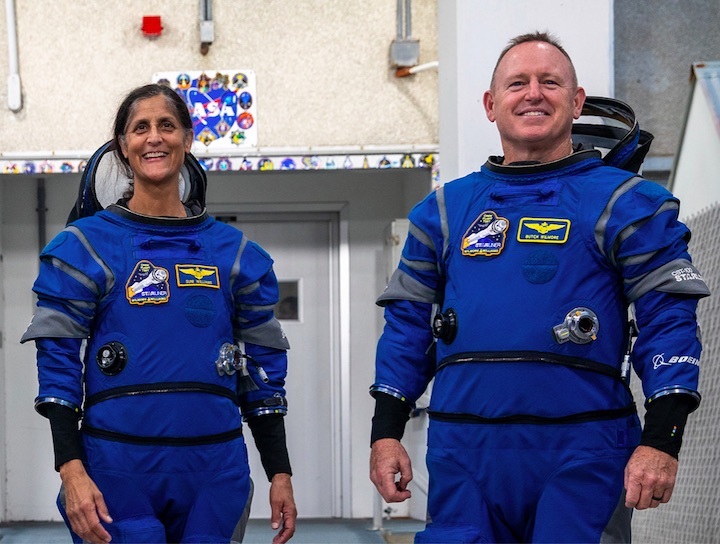
Boeing has finalized the design of its first crew mission patch after the astronauts assigned to the test flight were seen wearing an early version of the emblem.
The aerospace company is preparing for the third test flight of its CST-100 Starliner commercial spacecraft. The Crew Flight Test (CFT), targeted for April, will mark the vehicle's first launch with astronauts on a short duration mission to and from the International Space Station. NASA astronauts Barry "Butch" Wilmore and Sunita "Suni" Williams will fly the Starliner on its planned final shakedown cruise before it begins carrying four-person crews on NASA-contracted flights supporting the orbiting complex.
Both Wilmore and Williams helped redesign the CFT patch, replacing a versionthat dated back before their assignment to the mission. Wilmore and Williams are represented in the final design through the use of specific colors and details.
The prominence of orange, for example, surrounding the Starliner and United Launch Alliance (ULA) Atlas V rocket is based on the hue's traditional association with flight testing. The choice of "flight test orange" is also a nod to the astronauts' own experiences in qualifying new vehicles.
Both Wilmore and Williams are experienced naval aviators and test pilots, who combined have spent 11,000 hours in more than 50 aircraft, including the F/A-18 Hornet, T-45 Goshawk, H-46 Sea Knight and V-22 Osprey.
"We wanted to incorporate [in the design of the patch] all aspects of the CFT mission to include launch and the primary focus of the mission as being a first flight test," said Wilmore, in a statement released by Boeing on Thursday (Jan. 5).
In October of last year, Wilmore and Williams wore an early version of the CFT patch while taking part in a validation test at NASA's Kennedy Space Center in Florida. The embroidered emblem was similar to the final design, but some of the lettering was sewn using yellow thread instead of orange.
The earlier version also omitted identifying that the flight was a Boeing and NASA endeavor. The names of both entities have now been added to the patch.
With the reveal of the finalized art, Boeing also shared insight into the inspiration and symbolism behind some of the design choices.
The patch's outline of the Starliner and Atlas V represent the future of commercial human spaceflight. The border, according to Wilmore, also honors those who have been a part of the evolution of the Boeing capsule, from its first designers to those who fabricate, operate and will fly the spacecraft.
The blue marbling of Earth symbolizes Williams' love of the ocean and highlights the role of the CFT Starliner spacecraft, named "Calypso," as the gateway to doing research off the planet just as Jacques Cousteau's research vessel Calypso did on Earth. Williams christened the capsule following its first launch into space, Boeing's first Orbital Flight Test (OFT), in 2019.
The depiction of the International Space Station signifies Starliner's destination in space and both astronauts' time as crew members on the orbiting laboratory.
Finally, the seven stars surrounding the space station are meant as a reminder of the astronauts who traveled to space during NASA's Mercury program, while the astronaut symbol between Wilmore and Williams' names represents all who will follow in their footsteps after Starliner receives its safety certification from the U.S. space agency.
Wilmore and Williams will be the first astronauts to launch atop an Atlas rocket since the four Mercury orbital flights piloted by John Glenn, Scott Carpenter, Wally Schirra and Gordon Cooper in 1962 and 1963.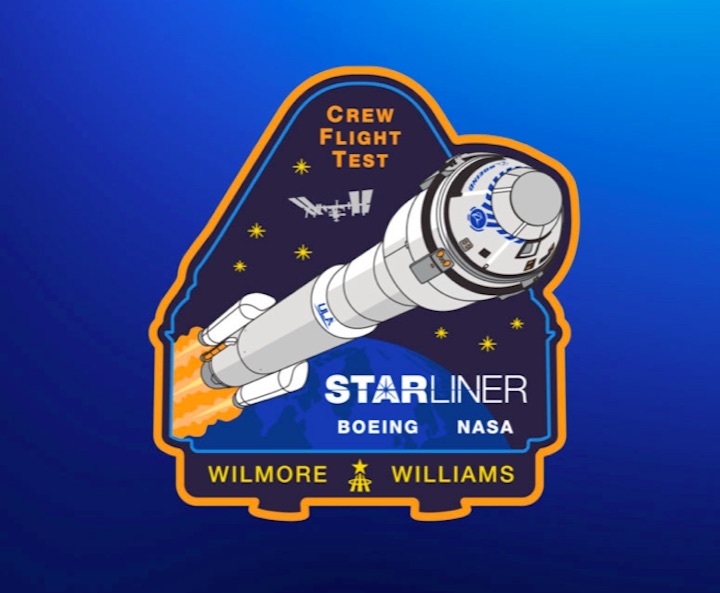
"Historically mission patches have included seven stars, which signifies the history of human spaceflight, all the way back to the original Mercury 7," Wilmore said.
Quelle: CS
----
Update: 26.01.2023
.
Boeing CST-100 Starliner Crew and Service Modules Mated
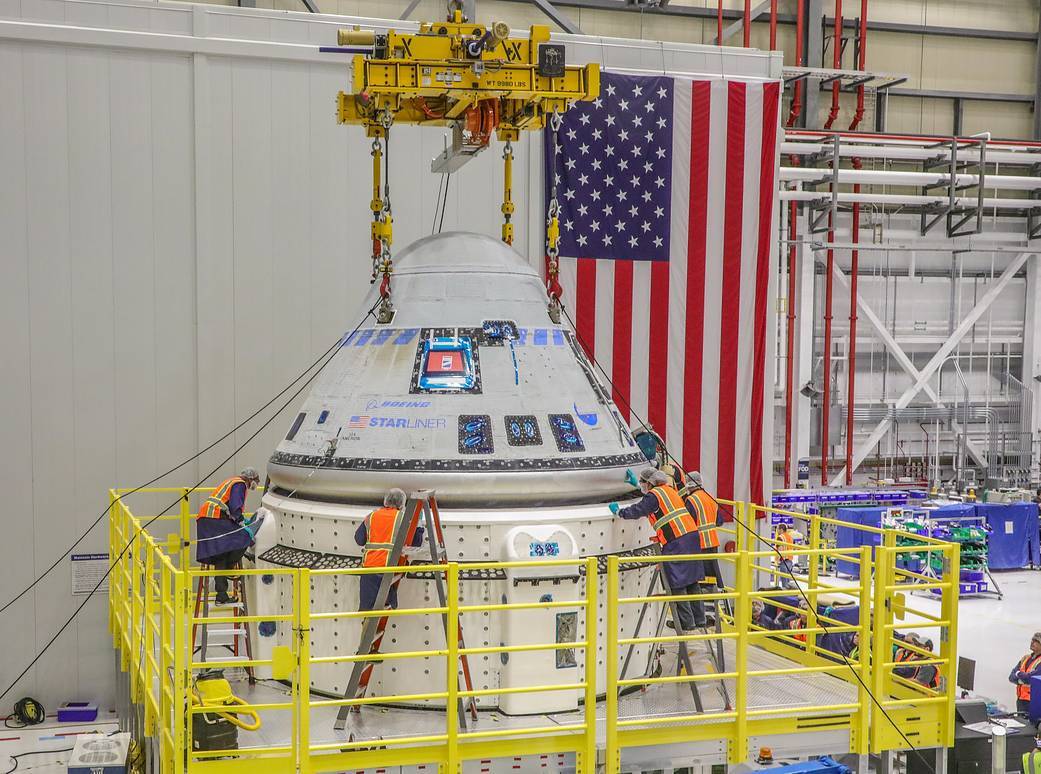
The Boeing CST-100 Starliner’s crew and service modules were connected, or mated, on Jan. 19 in advance of the first launch with astronauts to the International Space Station on the company’s next-generation spacecraft.
During the operation inside the company’s Commercial Crew and Cargo Processing Facility at NASA’s Kennedy Space Center in Florida, a crane lifted the reusable crew module atop the brand-new service module to become a fully operational spacecraft.
The complete spacecraft will fly NASA astronauts Barry “Butch” Wilmore and Sunita "Suni" Williams to the space station for NASA’s Boeing Crew Flight Test as part of the agency’s Commercial Crew Program. Starliner will launch on a United Launch Alliance Atlas V rocket no earlier than April 2023 to test the end-to-end capabilities of the Starliner system prior to regular flights with crew to the station.
Quelle: NASA
----
Update: 19.02.2023
.
NASA and Boeing still working through final steps of Starliner's astronaut test flight
The first crewed flight of Boeing's Starliner spacecraft remains set for later this spring, NASA and Boeing officials said Friday, though a target launch date has yet to be determined.
Starliner, built under the same NASA program as SpaceX's Crew Dragon capsule, is years behind schedule and has suffered a series of high-profile setbacks, including an uncrewed test flight in 2019 that was cut short before reaching the International Space Station. That mission was eventually redone and completed last May.
Meanwhile SpaceX has flown seven crewed missions to the ISS and is set to launch its eighth later this month.
Teams remain on schedule and are working through final steps ahead of Starliner's end-to-end stress test of its human transportation system capabilities, mission managers said during a press briefing Friday, offering few other major updates.
"We are taking our time and being very diligent as we work through the final preparation of the flight hardware, the flight software, the crew training, and closing out all of the certification products," said NASA's Steve Stich, manager of the agency's Commercial Crew Program.
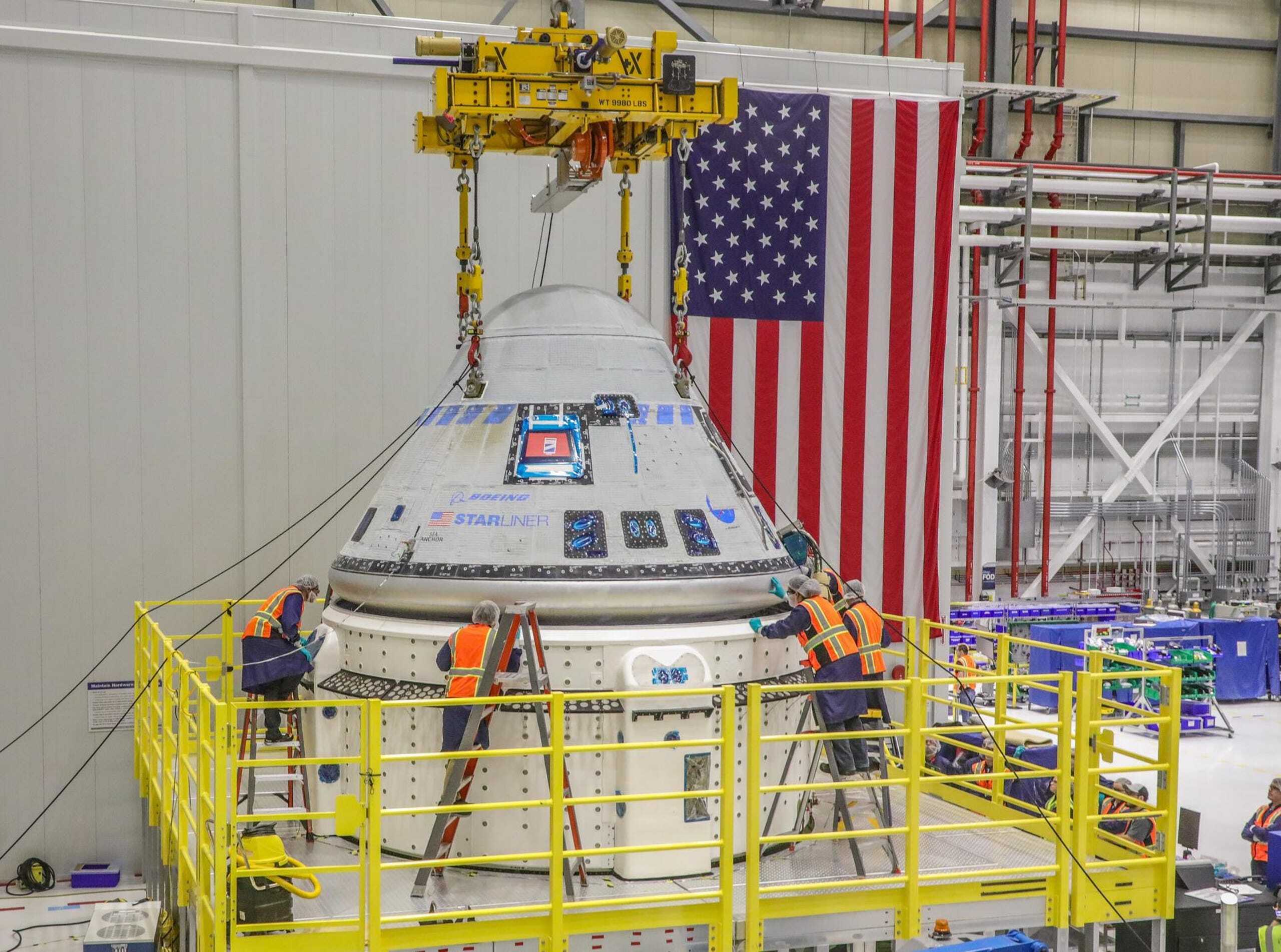
The Starliner team works to finalize the mate of the crew module and new service module for NASA's Boeing Crew Flight Test that will take NASA astronauts Barry “Butch” Wilmore and Sunita “Suni” Williams to and from the International Space Station.
"When we look at the (Crew Flight Test) mission, just from the station manifest perspective, the window is kind of the middle of April to the end of April. That's what we're looking at," Stich told reporters.
That final launch window will be dictated by a busy season of crew and cargo space station traffic in the first part of the year and potential priority conflicts with the launch partner, United Launch Alliance.
Expected to be the last in a series of test flights, Starliner's Crew Flight Test is designed to certify Boeing's human transportation system for future long-duration ISS missions for NASA.
"NASA and Boeing are working together to close out all that certification and analysis work. This is the final piece to say that the vehicle is ready to go fly the missions and become human rated," Stich said. "We're about 80% through that work."
The Crew Flight Test suffered delays last November, shifting from a targeted February launch date to one later in April. According to a NASA blog post, that decision was made to deconflict with space station traffic and provide more close out time for the Boeing team.
If the timeline shifts any later in the year, the Crew Flight Test could coincide with ULA's inaugural launch of its upcoming Vulcan Centaur rocket. Launch priority would then have to be determined since the Vulcan and Starliner's ride, ULA's Atlas V rocket, use the same Cape Canaveral Space Force Station launch pad.
"At the beginning of May, we're still okay. If we start slipping past that, we'll have to have some pretty good discussions with ULA on on who goes first," said Boeing's Mark Nappi, vice president and Starliner program manager.
Nappi is confident that Boeing's teams are right on pace to make an April launch attempt telling reporters, "the hardware is stacked, it's been mated, it's in what we call the hazardous processing area. We're doing final integrated testing there."
"The crew will be down next week, and we'll be doing our crew interface test," said Nappi in regards to the opportunity for the two Crew Flight Test NASA astronauts, Sunita "Suni" Williams and Barry "Butch" Wilmore, to travel to Florida and run through final launch-day preparations inside the Starliner.
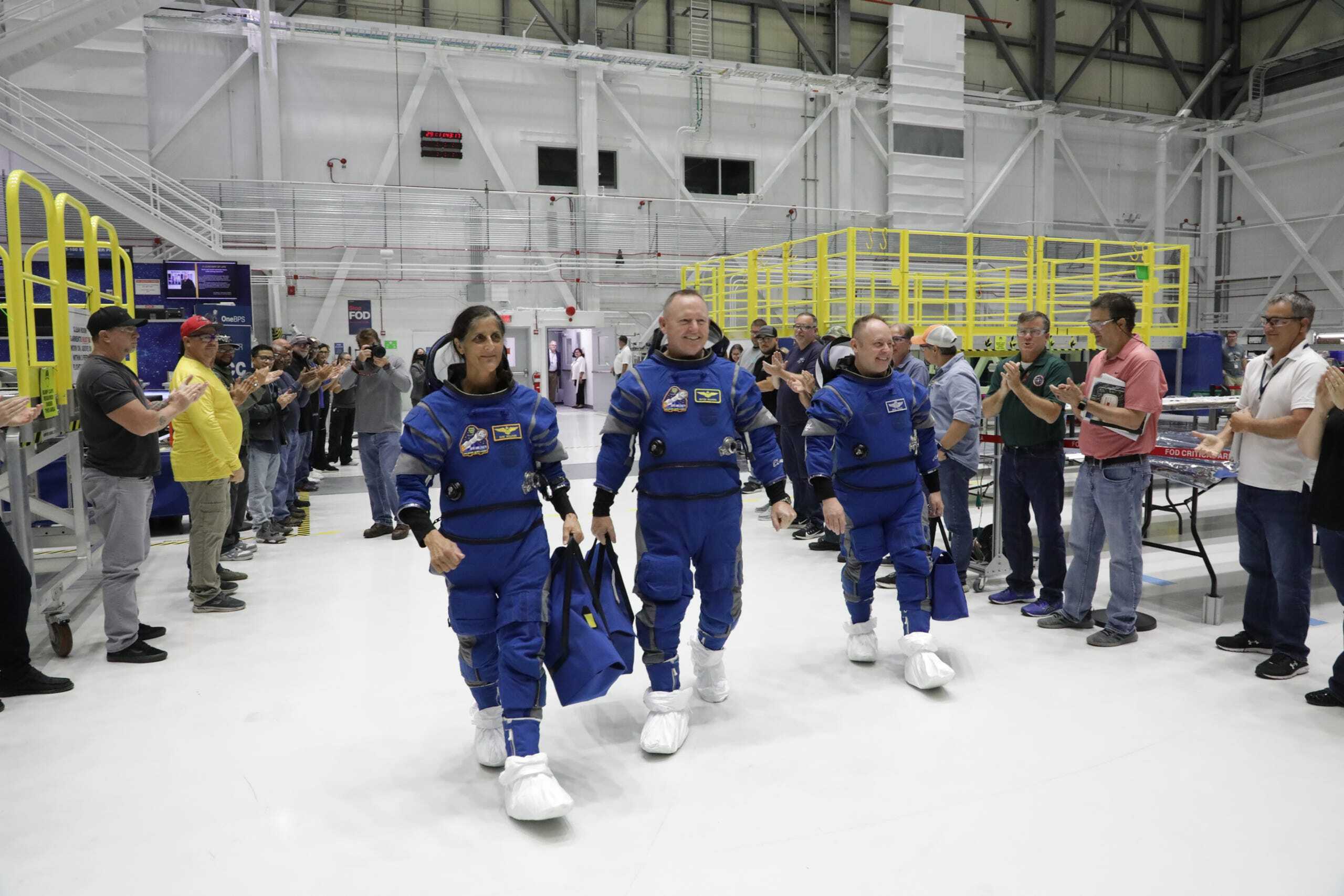
The NASA astronauts for Boeing’s Crew Flight Test (CFT) arrive in the high bay of Boeing’s Commercial Crew and Cargo Processing Facility at NASA’s Kennedy Space Center in Florida on Oct. 18, 2022. From left are Suni Williams, pilot; Barry “Butch” Wilmore, commander; and Mike Fincke, CFT backup spacecraft test pilot.
"We're going to do that in two parts," said Nappi. "The first part will be next week, and then after the cargo is loaded, we'll do the second part at the beginning of March."
Beyond that, a last step that must be completed within 60 days of a launch attempt is loading propellants onto Starliner, "which is a real big milestone for us," Nappi said.
However, NASA has much to get through in the coming weeks before Starliner gets its turn to dock with the station.
In just over a week, NASA's SpaceX Crew-6 mission is slated to carry four astronauts to the space station for the next long-duration science mission. About five days after that mission docks, the Crew-5 astronauts who have been on station for about six months are set to return and splashdown off the coast of Florida.
Then, on March 10, the next SpaceX space station cargo resupply mission is set to liftoff from Kennedy Space Center. Also, around that time, an empty Russian Soyuz crew spacecraft will dock at the station to replace a faulty one that sprang a leak and was deemed unsafe to return crew in.
For the most up-to-date information about launches from Florida, visit floridatoday.com/launchschedule.
Quelle: Florida Today
----
Update: 27.02.2023
.

